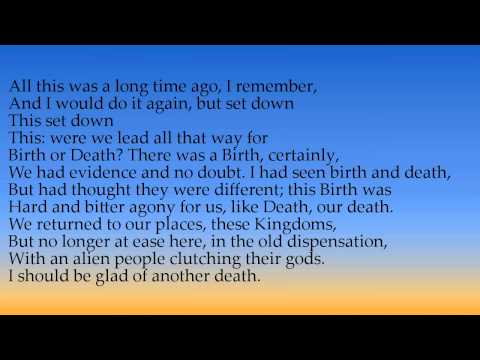4.35: Lesson 15: Allusions, Direct Addresses, and Symbols in Poetry
- Page ID
- 87458
Definitions
Allusions in Poetry
An allusion is a reference to something or someone in history. The allusion is intentionally placed in a piece of writing by the writer, and the writer assumes that the readers will know and understand the allusion.
Different types of allusions exist: Biblical, historical, literary allusions–to name a few. For example, watch this video where T. S. Eliot’s poem “The Journey of the Magi” is read:
Notice the biblical reference to the magi (wise men) who followed the star to Bethlehem, the birthplace of Jesus.
Direct Address in Poetry
A direct address may be a person, who is referenced in the poem. The person can be an actual person’s name or it can be a common noun in reference to a specific type of person. For example, Walt Whitman referenced strangers and readers in these two excerpts from Leaves of Grass:
Stranger
Author: Walt Whitman
Stranger, if you passing meet me and desire to speak to me, why
should you not speak to me?
And why should I not speak to you?
Thou Reader
Author: Walt Whitman
Thou reader throbbest life and pride and love the same as I,
Therefore for thee the following chants.
A direct address in poems can also be to an inanimate object. For example, John Donne directly addresses death in his poem “Holy Sonnet 10” also known as “Death Be Not Proud”:
Holy Sonnet 10
Author: John Donne
Death be not proud, though some have callèd thee
Mighty and dreadfull, for, thou art not so,
For, those, whom thou think’st, thou dost overthrow,
Die not, poore death, nor yet canst thou kill me.
From rest and sleepe, which but thy pictures bee,
Much pleasure, then from thee, much more must flow,
And soonest our best men with thee doe goe,
Rest of their bones, and soules deliverie.
Thou art slave to Fate, Chance, kings, and desperate men,
And dost with poyson, warre, and sicknesse dwell,
And poppie, or charmes can make us sleepe as well,
And better than thy stroake; why swell’st thou then;
One short sleepe past, wee wake eternally,
And death shall be no more, death, thou shalt die.
Symbols in Poetry
A symbol in poems represents something else–a deeper meaning. Poems can have a literal meaning, but they can also have a deeper symbolic meaning. For example, in Robert Frost’s well-known poem “A Road Not Taken” on a literal level it is about a walk in the woods. However, on a symbolic level it’s about making a life decision and how one decision leads a person down one life path and not the other.
The Road Not Taken
Author: Robert Frost
©1916
Two roads diverged in a yellow wood,
And sorry I could not travel both
And be one traveler, long I stood
And looked down one as far as I could
To where it bent in the undergrowth;
Then took the other, as just as fair,
And having perhaps the better claim,
Because it was grassy and wanted wear;
Though as for that the passing there
Had worn them really about the same,
And both that morning equally lay
In leaves no step had trodden black.
Oh, I kept the first for another day!
Yet knowing how way leads on to way,
I doubted if I should ever come back.
I shall be telling this with a sigh
Somewhere ages and ages hence:
Two roads diverged in a wood, and I—
I took the one less travelled by,
And that has made all the difference.
- Lesson 15: Allusions, Direct Addresses and Symbols in Poems. Authored by: Linda Frances Lein. License: CC BY: Attribution
- Journey of the Magi. Authored by: T. S. Eliot, Read by Martin Harris. Located at: https://www.youtube.com/watch?v=KBg_aYvp5GU. License: CC BY-SA: Attribution-ShareAlike. License Terms: Standard YouTube License
- Holy Sonnet 10 Death Be Not Proud. Authored by: John Donne. Provided by: Wikisource. Located at: https://en.wikisource.org/wiki/Holy_Sonnets/Holy_Sonnet_10. License: CC BY-SA: Attribution-ShareAlike
- Stranger . Authored by: Walt Whitman. Provided by: Wikisource. Located at: https://en.wikisource.org/wiki/Leaves_of_Grass/Book_I. License: CC BY-SA: Attribution-ShareAlike
- Thou Reader. Authored by: Walt Whitman. Provided by: Wikisource. Located at: https://en.wikisource.org/wiki/Leaves_of_Grass/Book_I. License: CC BY-SA: Attribution-ShareAlike
- The Road Not Taken. Authored by: Robert Frost. Provided by: Wikisource. Located at: https://en.wikisource.org/wiki/The_Road_Not_Taken. License: CC BY-SA: Attribution-ShareAlike


